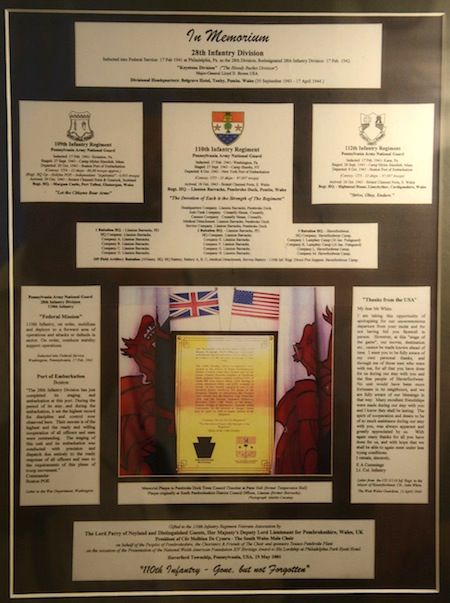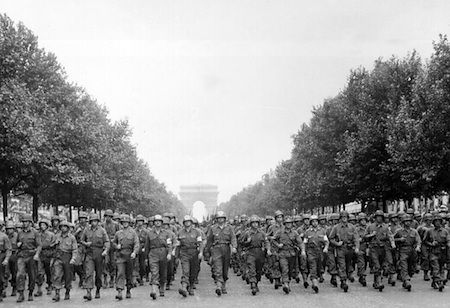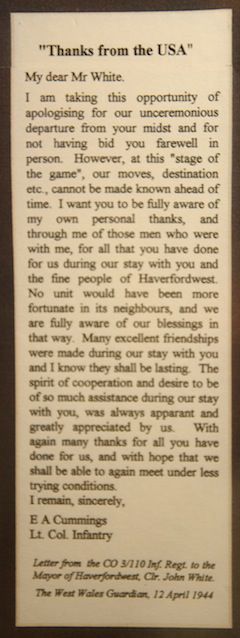The American 28th Infantry Division in Pembrokeshire
15th January 2016

In Memorium - 28th Infantry Division
On a wall in the Mayor’s Parlour in Picton House, Haverfordwest, is a framed mixture of certificates and letters relevant to the American 28th (Infantry) Division. Here’s why.
As the build up for D Day, 6th June 1944, progressed, so this country became inundated with American soldiers destined to become part of the biggest amphibious invasion force in history. Pembrokeshire was not excluded and for six months, beginning in late September 1943, became home to part of the 28th Infantry Division. Towns in Pembrokeshire, and further afield across south Wales, became the scene of columns of marching American soldiers.
At the start of the war the 28th Division had been part of the National Guard but was restructured to become a warfare unit with one of its earliest commanders being Omar N Bradley, later to become Eisenhower’s right hand man. The 28th was to become one of the most decorated infantry divisions in the Second World War. It began the war with the nickname of ‘The Keystone Division’ which by the end had been changed to, ‘The Bloody Bucket Division’.
The Division had a full complement of over ten thousand men. It was made up of three infantry regiments; the 109th, 110th, and 112th. Such a huge number couldn’t be housed in one county and the three regimental headquarters were situated in Port Talbot, Pembroke Dock and Llanybyther with the Divisional Headquarters at The Belgrave Hotel on the Esplanade in Tenby. A large number of those allocated to Pembrokeshire were given Picton Castle grounds on which to pitch tents and use as their base.
To have Americans marching through the streets of sleepy, isolated Welsh towns was certainly a novelty, partly due to the extreme contrast that they presented to the disciplined British army. Out of marching columns were witnessed men nipping out of line to buy a packet of cigarettes, or else soldiers would wave or wink at girls they’d spotted. Even the non commissioned officers were not averse to marching a squad under their command right up to within inches of an attractive young woman before issuing a command to halt or about face. (My mother was a ‘victim’ on more than one occasion).
After six months, and as the date assigned to D Day came nearer, the Division was moved closer to the ports from where they could be shipped to France and in July 1944 their turn came to be landed in Normandy. At the point that the Division had been billeted in Pembrokeshire, Major General Lloyd Brown had been the commanding officer. General Brown had difficulties and was replaced on the 12th of August by Major General Wharton. On the same day as being given command, General Wharton decided to inspect his new troops on the front line. He was shot dead by a German sniper. The Division was taken over by Major General Norman ‘Dutch’ Cota. Already a hero, General Cota had been heavily involved in D Day planning and was commanding troops on blood soaked Omaha Beach on the 6th June. He is often quoted as having told his men, ‘Gentlemen, we are being killed on the beaches. Let us go inland and be killed.’ By the 29th August, Paris had been liberated and the 28th Division was one of those represented in the ceremonial march through the city.

28th Infantry Division marching down the Champs Elysees
But then came the horror of the Battle of Hurtgen Forest, a few miles south east of the German city of Aachen. The area is a dense forest, which prevented air support for the ground troops and the German forces had prepared substantial defences. The 28th Division launched their attack on the 2nd November. Repeated attacks were consistently repulsed and the Division lost an incredible 6,184 casualties, the 112th regiment alone losing 2,300 out of 3,100. The Division returned to the United States in August 1945.

Letter from Lt Col E A Cummings of the 3rd Battalion, 110th Regiment of the 28th Division, thanking the then Mayor, John White. It is dated April 1944, before they had landed in Normandy
Part of the display in the Mayor’s Parlour is a letter of thanks to the Mayor and people of Haverfordwest from Lt Colonel Cummings of the 110th Regiment.
I am grateful to Haverfordwest Town Council and to Sue Murray the Mayor for having allowed the documents to be used.